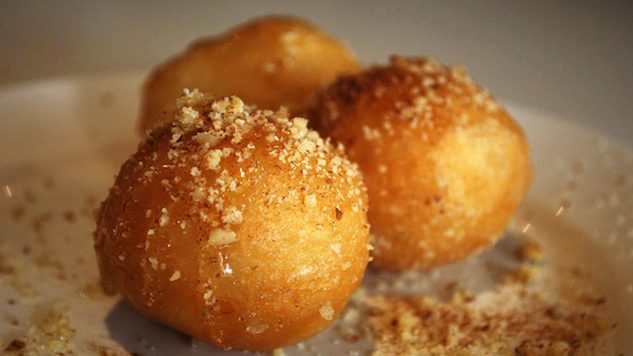A Baker’s Dozen Amazing Global Doughnuts

The doughnut represents an apex in human culture. We domesticated flour and yeast to make bread. We tamed fire to heat oil to frying temperatures. And we cultivated and manufactured sweetness, that ever-elusive natural flavor we crave so dearly. All of these triumphs of ingenuity combined, you’ve got one killer pastry to bring to your next meeting—and one that just about everyone in the world will recognize.
In the cultural cassoulet of the United States of America, we’ve embraced artifacts such as the zeppole, the cruller, the churro and the beignet. However, sweet balls of starchy goodness come from virtually every country on earth, and some of the most underappreciated ones can be found here with a little investigation. These 13 are worth the effort.
1. Loukoumades – Greece
Greek-American pastry shops are some of the happiest places on earth—not least of all for their embrace of local flavors—and these sweet morsels from the old country help take that joy to go. Similar to many fried sweets from the Mediterranean, loukoumades and their cousins Turkish lokma start with a yeast-risen dough and finish with hot oil and sugar. They can be rings, finger-shaped or spherical and topped with honey, sugar syrup, cinnamon and nuts.
2. Buñuelos – Latin America  Photo by ciroduran, CC-BY
Photo by ciroduran, CC-BY
The buñuelo is a pan-Latin American confection with a history as long as its versions are varied. Generally speaking, they are fluffy, round dough balls, sometimes filled with cream or custard, sometimes glazed with piloncillo syrup, sometimes flavored with anise. By some accounts, the buñuelo came to Spain from the Sephardic Jewish community, whose fried dough bimuelos are consumed at Hanukkah—not unlike the sufganiya (jelly doughnuts) eaten in Israel and America to commemorate the miraculous oil lamps of the Maccabees. Today they are consumed in Spain for All Saints Day and are popular at Christmas in Mexico.
3. Picarones – Peru Photo by Jared Cohee
Photo by Jared Cohee
These Peruvian street food favorites have the distinction of being pastries AND vegetables. Made from a dough of pureed squash and sweet potato (among other things) they are deftly manipulated into succulent O’s by expert handlers and hopefully served hot enough to toast your fingers a little.
4. Gulab Jamun – India Photo by Hari Prasad Nadig, CC-BY
Photo by Hari Prasad Nadig, CC-BY
Even the most backwater Indian restaurant in the U.S. is likely to feature these delightful little dough balls at the end of the buffet table. The primary ingredient in these is not flour but milk solids, fried and then soaked in sugar syrup infused with rose, cardamom and other flavors. These are served for special occasions all over the subcontinent and in hotbeds of the South Asian diaspora like Trinidad, Suriname and Guyana.
5. Jalebi / Zalabiya- South Asia, North Africa and the Middle East  Photo by Soumyadeep Paul, CC-BY
Photo by Soumyadeep Paul, CC-BY
Like buñuelos, jalebi (aka zalabiya, zoolbiya, zulbia) are pastries beloved across entire swaths of continent. These crispy little funnel-cake-like desserts’ ingredients vary in types of flour and flavoring, changing with the local tastes as the recipe made its way from the Middle East to South Asia through conquest and trade. Batter is piped in thin strands into shapes in the frying oil, resulting in crispy, delicate swirls, fingers or pretzel shapes. Depending on where you are, you could get honey syrup, powdered sugar, cinnamon, saffron, and other flavors. A popular celebration sweet all over India and western Asia, these should be easy to find.
6. Bamieh – Iran Photo by Hamed Saber, CC-BY
Photo by Hamed Saber, CC-BY
Bamieh are little finger-shaped nuggets of fried dough that rarely seem to make an appearance without their sister pastry, zoolbiya (see above), on Persian sweet plates. Chewy and dense contrasting zoolbiya’s crunch, bamieh are often covered in saffron and rose water syrup. They are the perfect size for sharing at a celebration, or for forgetting how many one has consumed with a cup of tea, just ‘cause.
-

-

-

-

-

-

-

-

-

-

-

-

-

-

-

-

-

-

-

-

-

-

-

-

-

-

-

-

-

-

-

-

-

-

-

-

-

-

-

-




 Photo by Hope Ewing
Photo by Hope Ewing









































